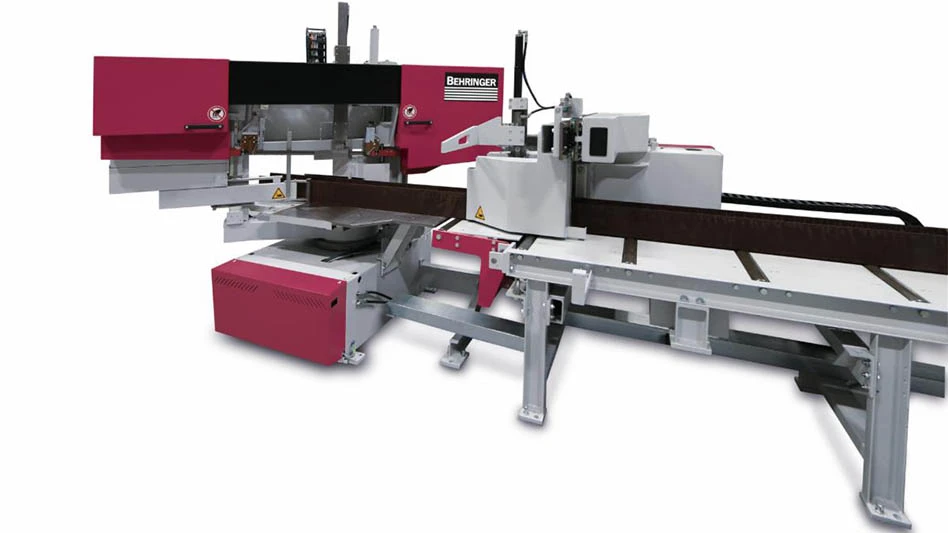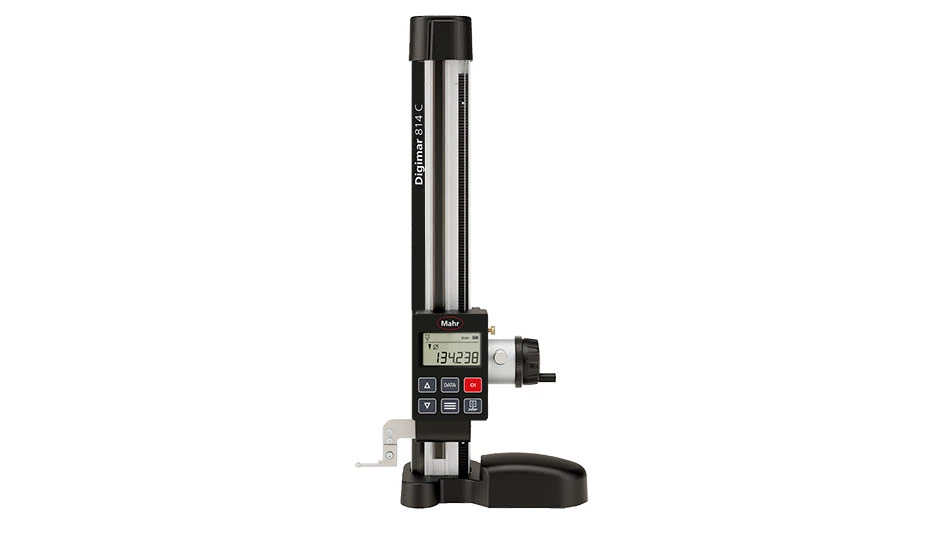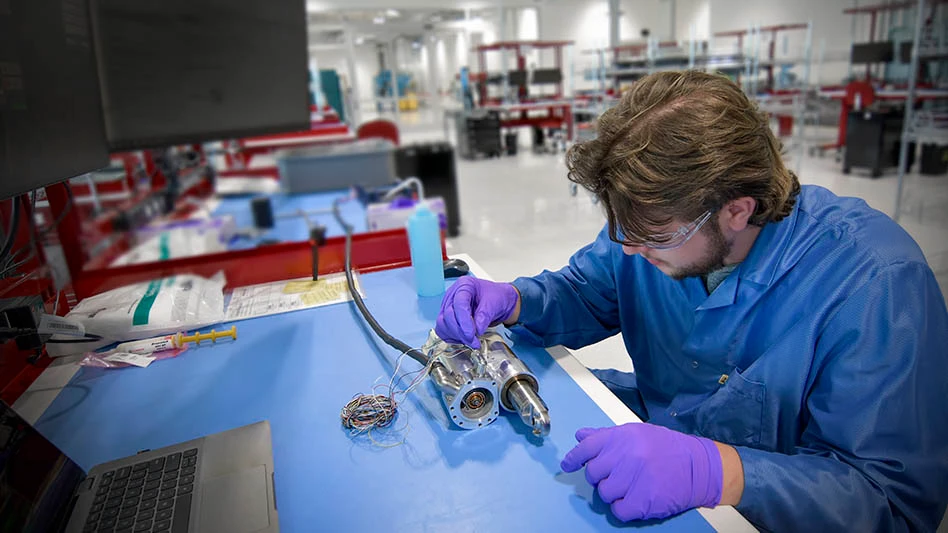
Machine tool executives from around the world gathered at the EMO Show in Hannover, Germany to discuss critical issues facing the industry. Sponsored by ATI Stellram, and moderated by Tom Grasson, associate publisher and editorial director of Today's Medical Developments and Aerospace Manufacturing and Design, the Roundtable generated differing opinions, thought-provoking suggestions, and even some agreements in regards to the direction machine tool builders must go in the coming years. Drawing on past circumstances as well as predictions for the future, the executives discussed an array of topics, from meeting customer requirements to dealing with increased productivity and improved quality.
Tom: Looking over the past five years, what new customer demands have been placed on the machine tool industry?
Chris Taylor, Chiron: They haven't really changed over the past few years, they've just gotten more demanding than they have been in the past. I think definitely our customer demands in direction of service and post-sale support has taken up a lot of our time in the last years. We are developing whole technologies for the customers, whole turnkeys for them where they want a complete solution, and not just a standard machine tool. They're looking for a lot more of this production support.
Ken Iwakura, Mitsui Seiki Kogyo: Many aerospace industries require more rigid, strong machines than before, and more hard-metal cutting machines, like aluminum cutting machines, are required. And we are working on that direction, very hard.
Bruno Schmitter, Hydromat: What I've seen over the last five years is that a new relationship has developed between our customers and ourselves, the suppliers – maybe more so in the high-volume business where we're in, but it's more adversarial than ever. It's not the partnerships anymore that we used to see, building a product together. It's basically ‘here is the purchase order, you'd better build it, you'd better build it on time, and you can't fail'?
Olaf Tessarzyk, Index: Uptime and production guarantees are a must for us and for our customers in this high-end market and in the high speed market. Favorable financing has become more and more important because we talk about high capital purchases. And the most important problem that we face is training. Lower cost and high frequency of employees – that's the biggest issue I guess all of us face in this high-end market. And I see this more as a partnership in regards to being there every time that the customer has a problem, and that develops more and more in the high-end market of machine tool sales.
Tom: History tells us that the machine tool industry is cyclical. Will it always be feast or famine, or do you see this changing? Explain why or why not.
Dr. Masahiko Mori, Mori Seiki: Well, I hope that will change. [There are currently] 6.5 billion people are living on Earth, so it is quite clear that by 2050, it's going to increase to 9 billion. And natural resources are limited, which means all of the environmental issues for us machine tool builders seems that people need more preciseness. And the other major factor is that people in China and India also want to raise their quality of life, same as the Americans or Germans or Japanese, so that the number of workpieces required for human beings is now increasing. So these are two important basic changes – the more preciseness and more workpieces – that will give the industry more opportunities than there used to be. So by 2020, I think that the average, the 4% to 5% growth of machine tool demand, will continue.
Dan Jenka, MAG: The cyclical nature of our business will probably never change; we'll always be dealing with cycles, but the magnitude as we look forward, we believe, will be far less than what we've experienced in the past. I think one other point is that we see some industries that are being driven now by technology – I'll use aerospace as an example – where the impact on the machine tool industry is felt in a positive manner with the application of new materials and new technologies to create a more efficient aircraft than in the past. So the consumption is not necessarily driven by capacity, but it's driven by technology. And we'll see that in other industry sectors as well: technology driving the need for consumption of our new technologies.

Harry Moser, Agie Charmilles: Overall I agree on globalization – it has increased diversity of markets, which therefore has reduced instability. But there's a chance, with globalization, that the U.S. market, for example, if the balance of trade continues to be bad, eventually the dollar could collapse. If the dollar collapses, the U.S. consumer, which has been the driver of the production all over the world – especially China, could stop buying because inflation would push the prices of things beyond his reach, and then we'd have a mess all over the world. So, globalization in the short run is positive, but it has some potential, if carried to the extreme and if the U.S. doesn't respond properly, to be devastating.
Tessarzyk: The markets keep fluctuating, but I think it's only country-wide. Globally, we see a little bit of a down turn in the U.S., but coming to EMO right now, my counterparts in Europe have never seen such a strong economy like current days. So, I think the overall machine tool consumption, globally, is not always that cyclical. It's cyclical in specific countries, but for a global machine tool company, the sales are steadily rising. The question ‘how big are they rising?' is dependent on where your major production site is located.
Larry Schwartz, Okuma: As with all markets, there will be peaks and valleys. There will continue to be hazards and volatility in our market along with cyclical trends, but not at the extreme levels we've seen before. The answer is globalization. Not only are the manufacturers balancing their global sales, but customers are also. This is going to positively help our market and the fluctuation we see. We're already seeing instances where domestically, a company's sales might be flat or even contract, but they are seeing well over 10% growth overseas. This trend keeps the company strong and their manufacturing needs much more stable than in the past.
Yoji Kato, Fuji Machine: I believe that this depends if you are speaking globally or regionally. China and other developing countries will most certainly have a significant impact. While developed countries stay cyclical, those that are in a state of increasing industrialization will have a tremendous growth curve. Tom: What is the single most critical issue facing the machine tool industry today?
Scott Kowalski, Tornos: Capabilities of machines have risen dramatically in the last ten years, so the consumption rate is on the decline due to the fact that you can create more, make more with the equipment that you have, versus 10 years ago you just go buy more equipment. Your operators and your owners of this equipment are now getting more versed on what this equipment is totally capable of. So, to me it's an upside, because you want them to get the most out of the equipment they purchased, but the amount of equipment that is necessary for them to purchase to create the backlog or workload that they have is going to be lower than it was 10 years ago. So that's something that we do see increasing the demand for consumption to increase the demand for machine tools.
Steve Lesnewich, Doosan: The demand is going away. We find that with manufacturing leaving the country, it has created a shortage that's a big problem for us. The other thing that's a big problem is the lack of skilled labor. It's not there, and trying to find it, trying to pick people up and running is very, very difficult.
Brian Papke, Mazak: I think there's a paradox in that the customers have to have more and more productivity improvement in order to compete on a global basis. And they need higher and higher spindle utilization in order to make use of that technology. But from a people standpoint, the skills, the people – particularly in North America – are lacking and there's a shortage of people coming into the workforce with training. And those two things are really working at odds with each other. So I think that's probably the most critical thing facing us in the machine tool industry right now.
Bob Murray, Haas Automation: In every market we're in, we see the same problem – lack of skilled labor. It could be in the U.S., it could be in Eastern Europe, it could be in China. Our machines are relatively simple to use, but I think they're still way too complicated, and that's going to be the key – we have to make our machines easier to use.
Tom: It's been said that machine tool customers don't fully understand the capabilities of the machine they have just acquired. Do you see this as a major problem? If so, what is being done to improve the situation?
Moser: I think the issue isn't just that they don't understand the machine that they've just acquired, but many of them don't understand the machine that they acquired five or 10 years ago. We did a survey of our customers when they called in for help and we asked them ‘Who trained you?' and it turned out that about 40% of the operators had hand-me-down training. They had never been trained by the OEM. We estimate that a oneweek operator training by us would give them at least a 10% productivity improvement, and I calculated a 300% return on investment on the time and the expense that they put into getting that training, and yet it's very difficult to get them to do so.
Tessarzyk: The biggest difference we face with our job shop-type environment is that to get somebody for training for a week is a problem because you don't have the slack in the production chain anymore. We started online training last year, which is interactive. We know all the young kids like computers, so we started an interactive training program two years ago with 23 chapters, where after each chapter the participant is asked 10 questions out of a selection of 300. Then if he passes the previous chapter, he can go to the next. They're highly interactive, internet-based, they can do it anywhere they want. This has proven to be very successful. We have also given that training program to the local tech colleges to entice young people to go back into manufacturing because we still face the biggest issue, which is "manufacturing is dirty." And it's not.
Lesnewich: When fully understanding the capabilities of these machines, we're finding in the high technology, a guy has a specific job that he needs to run. So he runs the job to that technology. The machine is capable of much more; at the time he purchased it, he really didn't need it. So what we've started to think about and try to do is have almost online training, but geared toward specific questions that that new owner has to his specific application to that machine tool. Because if you look at it, there's so much it can do, it's got a simplified application if I go to this application, what else do I need to know?
Thorsten Schmidt, DMG: I believe especially in developing countries, everybody's facing the revolving door of operators at a customer site. That's somehow the danger because you can't keep track of how often in Indonesia or Thailand or Vietnam the operators are changing at the customer's shop floor. So the challenges for manufacturers is what kind of intelligence is truly behind it so that on the one hand it's easy to use, but on the other hand you have a control system that is also for very intelligent people – where they can do a full simulation, they can do a shop floor programming adjustment on a turn/mill center? We don't want the dumb control systems; we want rather the intelligent control system that still saves the operator from making mistakes.
Dr. Mori: Some of the customers don't fully understand the capabilities of the machines, but when we develop the newest machines such as the simultaneous 5-axis machines or some of the integrated machines, some of the customers fully utilize the capabilities of these machines or sometimes they are giving us a great hint how to improve the machines or we need more functions, that kind of thing. So, as a machine tool builder, it's very important to find that very innovative customer who gives us advice, how to modify or how to make a new function.

Explore the November 2007 Issue
Check out more from this issue and find your next story to read.
Latest from Aerospace Manufacturing and Design
- Malaysia Aviation Group orders 20 more Airbus A330neo widebodies
- More displacement from space-tested piezo actuators
- Textron Aviation to bring its largest-ever lineup to 2025 EAA AirVenture
- Qualified materials for 3D-printing mission-critical applications
- #69 Manufacturing Matters - Shopfloor Connectivity Roundtable with Renishaw and SMW Autoblok
- Demystifying Controlled Unclassified Information (CUI)
- Simplify your shop floor operations while ensuring quality parts
- Happy Independence Day - July 4th





